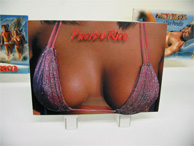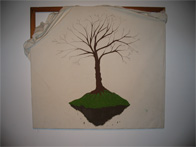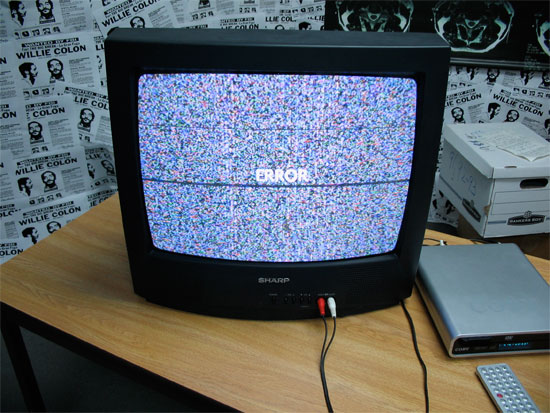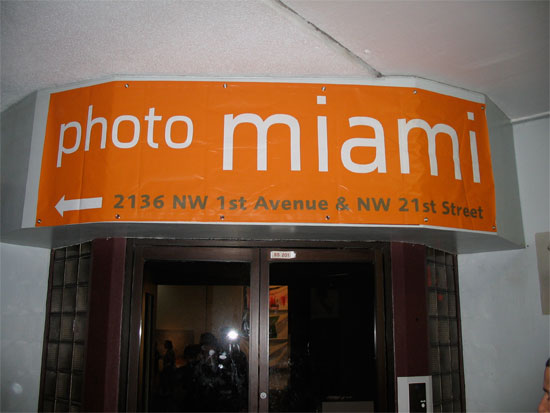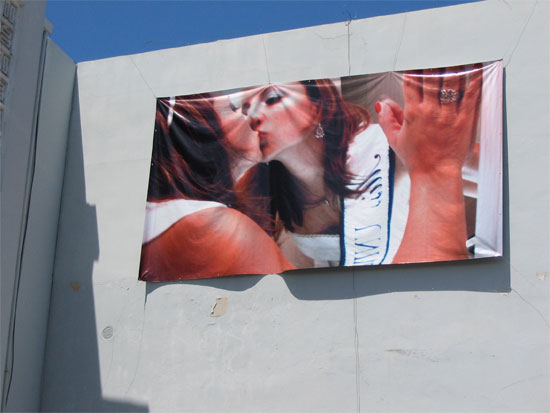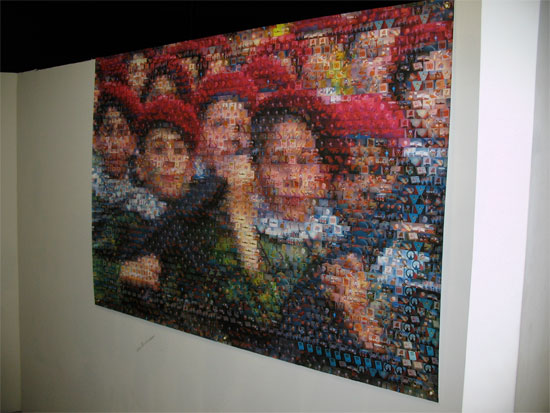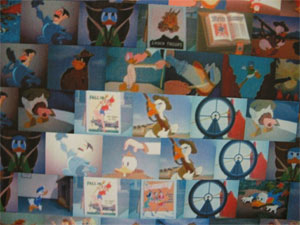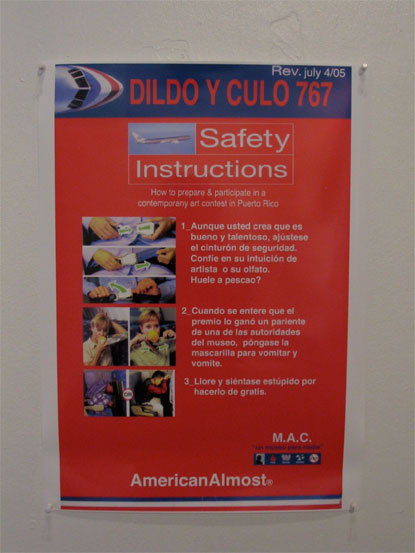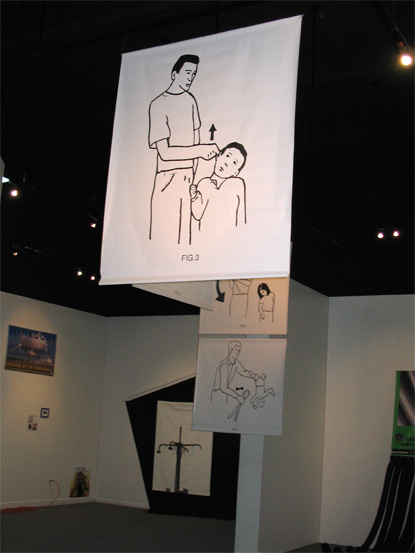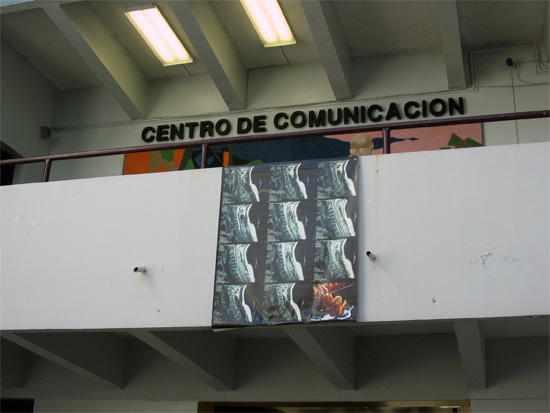|
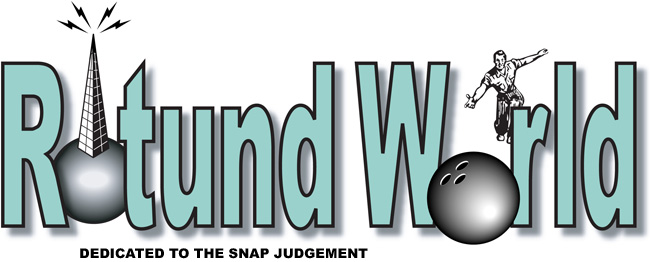
La Tierra Tiembla
For several months now we’ve been hearing a lot about the to-ing and fro-ing between Puerto Rico and points north and west, a bustle that seems qualitatively different from the usual visitas familiares, the shopping trips, the fed-up migratory door-slams. There is a distinctly tribal scent to all the hugger-mugger, a whiff of the sweat and other bodily fluids which youths exude while dirty dancing or playing their instruments. Could it be that the art world is in the midst of a significant turn of the generational screw —what the oracles call a shift in the paradigm—or is it just too much sugar, as usual? Possibly there is an answer to that question, although we won’t hear about it until the wise ones write the history of our times and the art-critical poobahs have their toity say. But consider for a moment the hothouse atmosphere of the contemporary art world where all of this giddy joysticking is taking place, a vortex of smiley-faced howdy-doism disguising business as usual: big fairs begetting little fairs, collectors trooping the globe with museum directors and their hirelings in tow, supposedly art-themed biennials falling all over themselves to be as glittery and Chatty-Patty as the fairs. The main result of this frenzy of inbreeding is that the art world is coming to resemble itself more and more grotesquely every day. A local outbreak of this dire trend is almost upon us; or its most obvious manifestation, the second edition of the international fair called CIRCA, is. The process itself is well-embedded in the system like a hardy virus, and the symptoms have already begun to show. Artists and their sponsors or caretakers or goads, whatever, have been flocking off to fairs like Art Basel Miami Beach, Art LA, and Scope New York, and straggling home with shit-eating grins and copious press clippings. Can any real good come of this? To get an idea of the ups and downs of our present situation, you have only to visit the Sala de las Artes at Universidad del Sagrado Corazon. There, a somewhat exploded, kind of splintered, distinctly morphed gathering of the artists who have been traveling the circuit are participating in an exhibition called The Dams 2, put together by our very own Pedro Vélez. We encourage you to pass by, and we leave it to you to decide if The Dams is damned smart, damned bad, or damned if you do and damned you don’t. Take your stamina pills. There’s a lot to see.
As we climbed the stairs to the exhibition opening night under the gaze of a photo- reproduction of a security camera, we came face-to-face with a paper intercom. Adding to the faux moment was a big banner affixed above the Sala’s entrance, announcing an art fair which ended three months ago, Photo Miami. Photo Miami was a fair within the fair-to-end-all-fairs, an annex to Art Basel Miami Beach wherein a group of island artists, organized by the selfsame Vélez, showed itself off to the world under the name of—are you ready?—The Dams. There is a whole lot of such cross-referential playfulness throughout the exhibition, not to mention a slightly uncomfortable echo of the Velezian method. One of the first things you encounter as you espy the Edificio Barat Sur where The Dams takes place, stuck high up on an exterior wall, is a banner with what appears to be two women kissing, by Rogelio Báez. Báez is not exactly known for his banners—in fact you might say that he is best known for not having a signature medium or way of working—and we were struck by how much the attitude, if not the exact imagery, of this piece reflects the let’s-smack-them-with-some- troubling-ambiguity mindset that prevails in everything Vélez touches.
Vélez gave us a somewhat satisfactory explanation for this. Working with the same young Puerto Rican artists he took to Miami, plus a few others he’s known over the years in places like Chicago, Houston, and Dallas, he played an active role in curating The Dams 2, just as he had in the earlier exhibition. In general he wanted the artists to work with the banner format, and to deal with it in a formal way rather than a polemical or narrative one. To us, the results are mixed. How could it be otherwise? Vélez’s own gnarled artistic penchants have a distinct if not easy-to-define character, having stewed in their own juices over many years, and it hardly seems likely that surrounding citizens, especially supple-minded youths, would remain unaffected. Just as we walked in the door, we saw the curator disappearing up a narrow spiral staircase we’d never noticed before, near the gallery’s front entrance. It turns out that there is a little warren of offices upstairs, and Vélez was doing some last-minute tidying up of the show. In the course of the evening we ran into artworks everywhere we turned: tacked about the building walls inside and out, standing in the parking lot vestibule, sprouting around the grounds like so much fake plastic shrubbery. Some of it resembles beer advertising—Medalla and Corona, island faves—or recruitment posters for the U.S. armed forces, and while this is aggravating at first glance, it is also completely plausible given the university campus setting, the sprawling art exhibition context, and the sponsorship-crazy times we live in. Which makes it a good joke once you get the idea.
The second thing that struck us about The Dams 2, besides its all-over-the-placeness, was how much spit and polish has gone into some of the works. These qualities, too, set The Dams apart from Vélez’s aesthetic. It’s not that his banners, posters, and constructions aren’t well-made, but a willful crappiness is frequently what he shoves our way; things not meant to be easy on the eyes. On the other hand, Nicole Rodríguez’s big pictures of serious people made up of small cartoon faces or Grady Pérez’s icy, graceful abstractions, to take but two random examples among many, are fun to look at, and for all their disturbances —Rodríguez’s Disneyesque characters include a cartoon Adolph Hitler—they bespeak meticulous, even fussy, habits of mind. This is a monster show, folks, and it would be difficult for one humble scribe—or, in our case, tribe of scribes—to catalogue and distinguish it all. But we’ll venture the following observations and snap judgments:
—There is a considerable amount of quasi-political commentary and social criticism amidst The Dams, and that’s a fine, even necessary development for our reactionary age. Some of it is merely suggestive, some gets at other things altogether than politics or social realities—including issues having more to do with art production than anything else—and some is stridently obvious and funny. The poster Dildo y Culo 767, a play on those widely- ignored airplane safety precaution cards, falls into the latter category, although it flogs a local artworld scandal that is as old as the hills by now, and we wish that more recent or ongoing, equally flagrant malfeasance would capture the artistic imagination once in awhile.
—There is more participatory art than we remember since we were hippie longhairs: Miamian Gean Moreno’s fabric-draped free-standing wooden panel to which some of Vélez’s students have attached collages and altered found-objects; the do-it-yourself graffiti wall, Brand Pollution, by Félix Agosto; the great Photocopy Me project—“we have no standards what so fucking ever”—which is a tonic to the money grubbing and preciousness of collecting of all kinds.
—One of The Dams best accomplishments is the way in which it seems to have leached the contaminants out of our cultural air and turned them into watchable objects. In this way the exhibition partakes importantly of the times, making the consumerist Zeitgeist or the state’s security-repression machinery, say, as much subjects of art as light once was, or the unsullied landscape. W&N’s stark black-and-white vinyl banners with their iconic portrayals of parents beating their children, Methods for the Obedience, deal at once with a serious, widespread social problem, the absurd admixture of both instructional and admonitory information that swarms about us like flies, and a kind of neo arte povera take on art-making.
The exhibition’s ideas are not nearly as fresh as their proponents probably think they are; yet the unstoppable bluster of the entire Dams 2 enterprise shares a spirit of adventure and daring with some of the avant-garde movements of the past—the Brazilian Neo-Concretists, Caracas throughout the 1970s, Cuba in the 80s—when low-grade production values and a defiance of norms propelled art into new territories. With its traveling carnival origins and dynamics, The Dams may actually resemble today’s experimental music scene more than yesterday’s artistic frontierland—you’ll have to ask Vélez about that—and in the end it might prove to be the proverbial flash in the pan. The “success” of some of the exhibition’s artists at recent art fairs means to us only that their work is adaptable to the machinations of the entertainment-industrial complex and of interest to Machiavellians ever sniffing the air for fresh meat.
Yet we believe that at the very least The Dams is an indication of how far the Puerto Rican art scene has evolved in less than a year. In May of 2006, when CIRCA was first unleashing itself on an unsuspecting, and, as it turned out, unready world, the three so-called “alternative spaces”—=Desto, Área, and the late, lamented tagRom—were what passed for excitement in the contemporary art scene. Last year’s exhibition El Polverío, organized by Osvaldo Santiago Arocho to coincide with CIRCA, included a scant handful of artists—most of whom appear this year in The Dams 2—and seemed like a poor, though ready and willing, country cousin to those projects. The contrast between then and now is startling to say the least. Is the scene catching up with the greater world, dashing ahead, or sure to founder in the overwhelming onrush of capitalist excess, not to mention boredom and doubt, those usual specters? Stay tuned. The Dams 2 will continue in la Sala de las Artes at Universidad del Sagrado Corazon until April 7, 2007. There should be someone to let you in to the second-floor gallery almost daily, Monday to Friday from 10 a.m. to 4 p.m. and Saturdays from 1 p.m. to 4 p.m. Don’t miss the lecture and free concert in the gallery by noise artist Jorge Castro on Friday evening, March 23rd, at 7 p.m. A second opening will take place in conjunction with the start of a new, eagerly awaited exhibition by Rigoberto Quintana on Wednesday evening, March 28th, at 8 p.m. CIRCA madness! Visit the Dams connection at the university’s website for the ususal blather: a complete list of artists, the whys and the wherefores, plus directions to the curator’s web sites where you will no doubt find more than you want to know. Helpfully, Vélez has complied very good images of the exhibition and its artworks. We have scanty information on the works reproduced above, but we’ll pass along titles and artists and, where we can, vital statistics. Surely the banners are printed on vinyl. Beginning at the top: a detail from Flat Security Services-Willie, a room-size installation by Juan Carlos Rodríguez, 2007. Next: a found banner from the 2006 art fair Photo Miami, courtesy of Rogelio Báez. Next: Miss-ED, a banner by Rogelio Báez, 2006. Next down: The Mahdi Boys, with detail, a banner by Nicole Rodríguez, 2007. Next: a poster provided by the artists Dildo y Culo, approximately 24" x 36", from 2005. Next: an installation shot of the exhibition with banners from the series Methods for the Obedience by W&N, 2006. Finally, an untitled banner by Juan Carlos Rodríguez, 2007. Find last episode’s good times here. |


